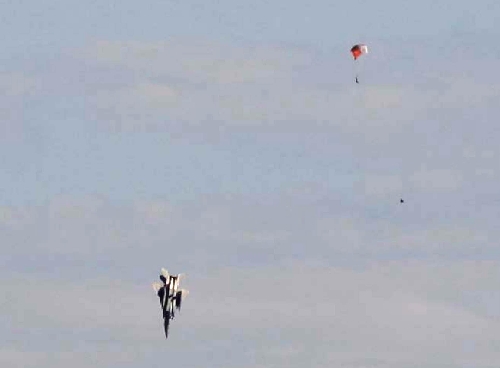Air Force cites factors in Oct. 24 crash

While Air Force investigators couldn’t say conclusively what caused an F-15C Eagle fighter jet to crash in rural Southern Nevada, they noted six factors in a report released Friday that might have played a role in the Oct. 24 accident.
The pilot, who wasn’t named in the report, ejected safely at about 1,400 feet above ground level seconds before the
$32 million warplane slammed into the rugged, high-desert terrain in Lincoln County, 85 miles northwest of the Las Vegas Valley. The pilot and the twin-engine fighter jet were assigned to the 422nd Test and Evaluation Squadron at Nellis Air Force Base.
Lt. Col. Dylan T. Wells, president of the Accident Investigation Board, concluded that because “so little evidence survived eliminates any ability to pigeonhole the mishap sequence into a singular cause that ‘derails the train.’ ”
But in the report’s executive summary he listed six contributing factors that were tied to the accident sequence.
“The contributing factors were links, which if broken, would have precluded aircraft loss,” Wells wrote.
The first three factors might have caused the aircraft to go out of control and into a spin. They included possible imperfections in the radome, the dome covering a radar or antennae, which might be bent or misaligned. Wells wrote that he observed many radomes with imperfections in a post-mishap survey of radomes at the Nellis base.
The second factor was the pilot’s failure to discuss advanced handling characteristics of the aircraft before flight, followed by the third factor: the pilot’s possible mishandling of flight controls.
The pilot’s “misperception of operational conditions” that the aircraft was going out of control was the fourth factor, followed by the pilot’s “failure to apply corrective actions” quickly and adequately. Finally, the pilot’s inability to recover from the spin before reaching ejection altitudes was the sixth contributing factor.
“Without further evidence it is impossible to attest to the timing; however, endgame images show proper flight control deflections for the spin encountered,” according to Wells.
The pilot had more than 790 hours of military flying time with most — 563 hours — on F-15C and F-15D aircraft.
The pilot was forced to eject after attempting an aggressive but unsuccessful dive recovery that involved lowering the landing gear.
The report noted that the No. 1 engine had been replaced on Oct. 4 for two compressor parts “being loose beyond limits.”
The No. 2 engine had been removed on Sept. 19 for maintenance to replace two cracked fairings, which reduce drag.
Investigators found that the pilot didn’t remember flight data link procedures for the day nor did the pilot enable the plane’s videotape recorder system. As such, there was no usable data retrieved from the Nellis Air Combat Training System.
Contact reporter Keith Rogers at krogers@reviewjournal.com or 702-383-0308.